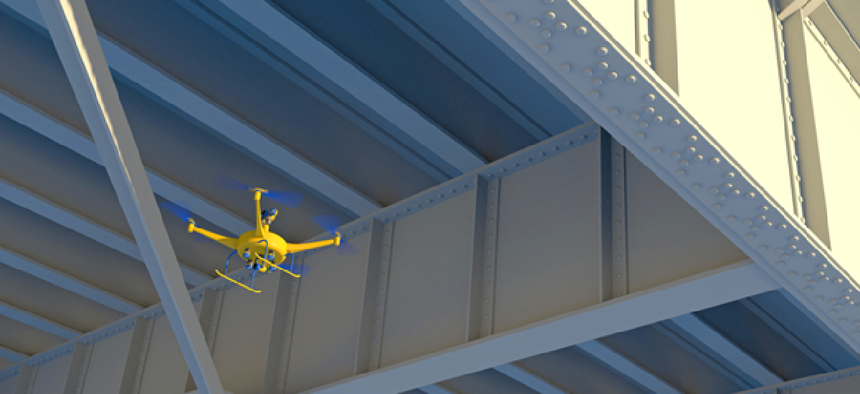Do drones have a future in DOTs?


Connecting state and local government leaders
Advances in sensors, mapping system accuracy and data management make unmanned aerial systems a high-value proposition for transportation departments.
Unmanned aerial systems have promised to make infrastructure inspection easier, prompting transportation departments across the country to experiment with the devices to get a closer look at bridges in particular. But how accurate are these UAS?
Drone-based sensor systems are now being put into the air with hardware that provides high-density point clouds at a lower cost than ground-based mobile mapping systems, according to Qassim Abdullah, a chief scientist and associate at Geospatial Services at Woolpert, who spoke at the Transportation Research Board’s annual meeting on Jan. 8.
Ground-based mobile mapping systems have traditionally been more precise, he said. But he was recently able to show that drone-based mapping systems can achieve a level of accuracy within about .2 feet horizontally, which will meet some state standards. Abdullah and other researchers said vertical accuracy for drones tends to be lower, though.
Test flights around the Woolpert headquarters showed how the drone, outfitted with a LiDAR system, was able to meet accuracy requirements if enough ground control points are in place. Ground control points are visual markers of known locations that the drone operator uses post flight to determine exact locations; the more points, the more accurate the flight, he said.
Colin Brooks, a senior research scientist at Michigan Tech who is working with the Michigan Department of Transportation on drone integration, said higher-quality systems that use correction technologies – like real-time kinematic and post-processed kinematic techniques -- can also improve accuracy.
Brooks has been testing a drone set up for MDOT that captures optical, thermal, hill-shade and other data from multiple sensors on the drone.
“It’s on the cusp of being adopted,” Brooks said of aerial imaging for transportation departments. “Things have really changed since the adoption of FAA Part 107 rules [for commercial use of drones] a year ago in August 2016. That’s made UAS deployment a lot more practical.”
Just as important as getting the drone in the air is managing the data and workflow after the propellers have stopped spinning. UAS-based sensor systems are creating a significant amount of raw data that needs to be processed and archived. The useful information will actually come from merged files that are smaller in size and can be kept on a geospatial cloud.
Brooks has been working with Surveying Solutions Inc. on what a cloud like this might look like. It should allow for research institutions and agencies to have access, he said, so multiple people can provide usable data. And metadata should include information such as the type of camera used for the flight. The final platform would allow users to select a location and then be provided with all the files available, whether thermal, video or LiDAR.
One roadblock for DOTs, Brooks said, is the Federal Aviation Administration's current beyond-line-of-sight rule requiring operators to be able to see their drone when it is in the air. This limits flights to about half a mile, he said, when “you’d like to do 10, 20, 40, 60 miles of road corridor” or multiple bridges in a location.
But FAA’s UAS Integration Pilot Program, which is meant to speed up the integration of drones into the air space, could lead to changes municipal pilots are looking for.
“I think that will be a lot more practical in making it [part of] everyday use,” he said.




